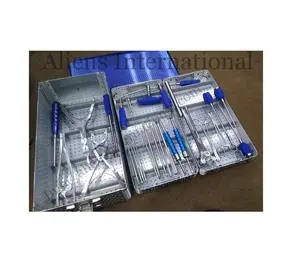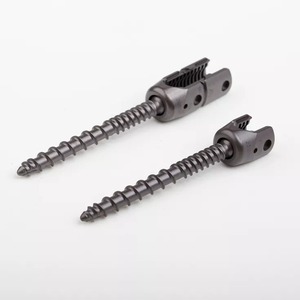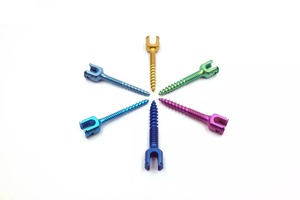(962 products available)

















































































































































































































Spinal fixation sets are several instruments, including spinal implants, to stabilize and fix the spine. The choice of the spinal fixation set is determined by many factors, like the type of spinal injury and fixation method. Here are the various spinal fixation sets commercially available:
This set is used for internal fixation of vertebras using rods, screws, and plates. The internal set provides stability by allowing for bone fusion over time. It is used in cases of major spinal injuries where internal stabilization is needed. The internal fixation method involves invasive surgery where implants are placed inside the body for stabilization. It is done with great precision using sophisticated imaging technologies. Common materials are titanium and stainless steel because of their toughness and capacity to withstand heavy loads.
The external fixation set stabilizes the spine using outside support like a halo or frame in mild to moderate injuries. This method is ideal for injured tissues to heal faster. It is less commonly used in direct injury to the spine and more in patients with severe burns, infection, or who are unfit for surgery. This type of fixation uses pins or screws that are fixed to the outer part of the bones and wrapped with a frame on the surface of the skin to hold it in place.
This is a basic but critical part of many spinal fixation sets. The rods and screws hook into vertebrae and provide stability in a fixed structure to allow pathological motion over time. It is most commonly used in deformity correction, tumor removal, and degenerative diseases. This system is employed when strong immobilization is necessary, as in idiopathic scoliosis or degenerative disc disorder.
This is a new method that involves inserting a device between two vertebrae to provide direct stabilization. It is ideal for minimally invasive surgeries. This device allows for some motion while helping the vertebrae fuse over time. It is mainly used in disc replacement techniques and vertebroplasty.
This material is employed in all spinal fixation devices because of its sturdiness and toughness. Titanium is lightweight, incredibly strong, and holds up to bodily fluids and bone integration without causing adverse reactions. It is commonly used for internal fixation devices like rods, screws, and plates.
Stainless steel is used widely for making spinal implants because of its exceptional strength, durability, and resistance to corrosion. It also has excellent biocompatibility, making it safe to use within the human body. In addition to internal fixation devices, the material is used for making bone screws, rods, and external fixators used in spine surgeries. It is economical and easier to manufacture into complex shapes needed for various implants.
Other Spinal fixation sets incorporate cobalt-chromium alloys into their design. They will provide added strength and increased resistance to wear and fatigue. This alloy is commonly used in load-bearing spinal implants like cages and disc replacement devices.
Carbon fiber composite is lightweight and gradually becoming more popular. Its primary purpose is to provide rods used in spinal fusion surgery. Radiolucent properties ensure that post-operative imaging focuses on anatomical structures and does not obscure important views of the spine. Due to its lightweight design, the patient experience improves, and stress on surrounding structures reduces carbon fiber composites. Although more expensive than traditional materials, they are useful in many high-tech spinal correction systems.
Wear-resistant ceramics are used to make intervertebral devices. These devices include vertebrae substitutes and artificial disks, which have been clinically proven to offer superior wear resistance against the rubbing surfaces of joint implants. Ceramics include alumina and zirconia, which are ideally suited for their production due to their strength and biocompatibility. They also provide smoother surfaces that minimize wear on adjacent vertebrae.
Choosing a spinal fixation set involves considering several factors, as discussed below:
The first factor is the type of spinal surgery. The nature of the spinal surgery will dictate the fixation set. The options include rods, screws, and plates for complex surgeries. An external fixator is used for stabilization without internal implantation. Intravertebral devices are used for minimally invasive procedures.
The second factor is the method of fixation. Spinal implants are meant for internal stabilization using screws and rods. The external fixator stabilizes them through external structures. Intravertebral devices provide stabilization between vertebrae for minimally invasive procedures.
The third factor is the degree of fixation. Stability provides internal fixation through screws, rods, and plates. They allowed fusion to take place, but they could not allow motion. Semi-rigid systems enabled some motion while stabilizing the vertebrae to allow the healing process.
The fourth factor is compatibility. Modern spinal fixation sets are made using titanium and stainless steel for maximum stability. Hybrid systems are compatible with different metal alloys.
The fifth factor is the ease of installation. Most of them have features like self-locking mechanisms and modular designs that make their installations faster and easier.
The last factor is the cost and availability of spinal fixation sets. Even though stainless steel is cheaper, titanium works better in the long run. Internal fixation systems use more complex rods and screws than external fixation, making them more expensive.
Here are guidelines on how to use a spinal fixation set correctly:
The type of spinal surgery to be undertaken will determine which tools to use. Open surgeries use plates, rods, screws, and spinal staples. Orthopedic bone screws and intervertebral implants are used in closed surgeries.
The next step is to prepare the instruments and components well. Ensure that the screws, rods, or plates are available in all sizes and variants.
Then, after anesthesia, the surgeon will create an incision in the back or abdomen of the patient. They will then retrieve the realigned vertebra and hold it in place with screws and rods.
Then, proper alignment is ensured. The surgeon uses a C-arm to ensure the proper measurements have been maintained. The fixation device is fixed to stabilize the spine.
Finally, the surgeon will close the incision after ensuring that the alignment is in place. They will also advise the patient about the recovery process and how to avoid additional injuries.
Repairing or correcting damage to a spinal fixation set requires taking specific measures, depending on the kind of damage to the spinal integrity and the injury's severity. In less severe instances, external fixation devices may be employed. They are adjusted to maintain proper spinal alignment once stability is restored. In severe cases where there is internal fixation, like the damage of screws, rods, or plates, revision surgery will be needed to either replace the damaged component or repair it.
Moreover, in cases where the implant is loosened but has not suffered any significant damage, it can be remedied through augmentation procedures. Bone cement is injected into the area to provide extra support. In the event of metal fatigue or breakage, orthopedic bone repair must be performed. This involves doing an incision to allow direct examination of the internal fixation, followed by re-fixing or replacing the components.
In situations where the fixation has failed due to biological reasons, i.e., failure to fuse, other means are used to encourage the fusion process. This can include grafting extra bone or using biologically active materials like growth factors. Conversely, infection can compromise a spinal fixation set. It is addressed by administering antibiotics or performing surgery to remove the implant and address the infection directly.
Proper maintenance is crucial in preserving the integrity of spinal fixation sets and reducing their chances of failure. Here are some of the key maintenance tips:
In unimaginable spine surgery, the frameworks and components used in spinal fixation should be scrutinized every time the patient comes for normal hospital checkups. This helps to catch signs of maladies or failure very early, like corrosion, fatigue, or loosening. In some situations, imaging tests may be necessary to assess the fixation set's situation internally.
Sterilization of the spinal fixation set is important before any surgery involving its use. This is to avoid any infection. Autoclaving is commonly used to sterilize stainless steel and titanium instruments.
Although the components used in spinal fixation are strong and durable, they should be handled with care to avoid bend or break. The instruments should be cleaned after every use with a soft brush and a neutral detergent to avoid corrosion and wear.
Spinal fixation sets should be stored in a dry, dust-free environment. Exposure to moisture can cause corrosion, while dust can affect the mechanical operations of some parts.
Regular maintenance of the spinal fixation set should be done using lubricants appropriate for the metal type. This ensures smooth mechanical functions and reduces wear and tear.
Here are some suggestions on preserving spinal fixation sets:
Cases where spinal fixation failure occurs are quite rare. Nonetheless, patients with spinal fixation sets are advised to avoid impact. They include heavy lifting, high-intensity exercises, or activities that involve sudden movements, twisting, or bending. These activities can exert excessive forces on the spinal implants, resulting in mechanical complications like loosening or bending of the rods and screws.
Patients must also wear braces to support the spinal fixation set. This reduces the movement around the surgical site and enables the implants to facilitate good fusion faster. Depending on the situation, doctors use either rigid or flexible braces to stabilize the spine and minimize dynamic loads on the hardware. Most patients with a fixation set in place are prescribed medications like analgesics and anti-inflammatory drugs. They temporarily relieve pain and reduce inflammatory reactions, which could otherwise exert forces on the fixation set and destabilize it.
Patients with spinal implants must avoid exposure to corrosive substances like certain metals and chemicals. These agents can lead to oxidation and corrosion of the metallic implants like titanium and stainless steel, reducing their mechanical integrity. Patients who have spinal fixation sets commonly contain magnetic metals like stainless steel.
Fixation sets should be kept away from powerful magnetic fields. They are found in magnetic resonance imaging machines. Although limited, spinal magnets may cause the fixation set to move or rotate in a manner that is unsafe. This can harm the hardware or cause internal injury to the patient.
A1: Spinal fixation sets are used for stabilizing the spine during surgical procedures to treat conditions like fractures, deformities, or degenerative diseases.
A2: Spinal fixation sets are made of titanium alloys and stainless steel because they are strong, corrosion-resistant, and biocompatible.
A3: Most spinal fixation sets contain screws, rods, plates, intervertebral spacers, and bone grafts to stabilize movement and promote fusion.
A4: The apparatus should be thoroughly cleaned and sterilized before storage to avoid corrosion. They should be packaged in sterilization pouches and dry.
A5: Spinal fusion is the most common surgical procedure. The goal is to join two or more vertebrae so that they heal into a single solid unit over time.